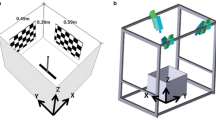Summary
-
1.
The visual control of ground speed in the flight of gregarious desert locusts, Schistocerca gregaria, was investigated under open- and closed-loop conditions. Locusts were flown tethered in a wind tunnel, and ground pattern motion in line with their longitudinal body axes was used to simulate the visual effects of headwind and tailwind while the locusts' flight thrust and yaw-torque were monitored.
-
2.
In open-loop experiments, a correlation between thrust and pattern speed modulation was observed only when pattern speed modulation crossed 0°/s, (i.e. when the pattern direction of movement reversed). Otherwise thrust was kept constant at one of two extreme levels, depending on whether patterns moved progressively or regressively. When pattern motion was stopped intermittently, thrust production approached a mean level between the two extremes, which was assumed to be a “preferred” value.
-
3.
In closed-loop experiments, a regressive bias of pattern motion used was counteracted by a compensatory modulation of thrust. Pattern speed was in this way minimized. Quality of bias compensation differed both between experiments and during an experiment. In some of the experiments, the residual mean slip speed, though variable, was proportional to the strength of the bias. In other experiments the pattern was stopped, except for a small amount of positional jitter, over a wide range of bias modulation.
-
4.
Compensation for the pattern motion bias was restricted to a limited range of bias modulation. Beyond this range, thrust was always strongly increased, independent of whether the biased motion was too slow or too fast for compensation by thrust modulation.
-
5.
The thrust response was often combined with a modulation of yaw-torque, especially when the biased pattern speed was beyond the range of compensation by thrust.
-
6.
The results from both open- and closed-loop experiments indicate that in visual control of ground speed locusts tend to minimize the retinal velocity of ground images. It is suggested that this may be a general characteristic of the visual flight control system in swarming desert locusts.
Similar content being viewed by others
References
Baker PS, Gewecke M, Cooler RJ (1984) Flight orientation of swarming Locusta migratoria. Physiol Entomol 9:247–252
Blondeau J, Heisenberg M (1982) The three-dimensional optomotor torque system of Drosophila melanogaster. J Comp Physiol 145:321–329
Casimir M (1987) Plague locusts in New South Wales: studies of migration and displacement of populations. New South Wales Dept Agric Bull 91
David CT (1982) Compensation for height in the control of groundspeed by Drosophila in a new, “barber's pole” wind tunnel. J Comp Physiol 147:485–493
Eggers A, Preiss R, Gewecke M (1991) The optomotor yaw response of the desert locust, Schistocerca gregaria. Physiol Entomol 16:411–418
Heisenberg M, Wolf R (1988) Reafferent control of optomotor yaw torque in Drosophila melanogaster. J Comp Physiol A 163:373–388
Heran H, Lindauer M (1963) Windkompensation und Seitenwind-korrektur der Bienen beim Flug über Wasser. Z Vergl Physiol 47:39–55
Junger W, Varjú D (1990) Drift compensation and its sensory basis in waterstriders (Gerris paludum F). J Comp Physiol A 167:441–446
Kennedy JS (1939) The visual responses of flying mosquitoes. Proc Zool Soc London A 109:221–242
Kennedy JS (1951) The migration of the desert locust (Schistocerca gregaria Forsk.). I. The behaviour of swarms. II. A theory of long-range migration. Phil Trans R Soc B 235:163–290
Marsh D, Kennedy JS, Ludlow AR (1978) An analysis of anemotactic zigzagging flight in male moths stimulated by pheromone. Physiol Entomol 3:221–240
Preiss R (1991) Separation of translation and rotation by means of eye-region specialization in flying gypsy moths (Lepidoptera: Lymantriidae). J Insect Behav 4:209–219
Preiss R, Gewecke M (1991) Compensation of visually simulated wind drift in the swarming flight of the desert locust (Schistocerca gregaria). J Exp Biol 157:461–481
Preiss R, Kramer E (1983) Stabilization of altitude and speed in tethered flying gypsy moth males: influence of (+) and (-)-disparlure. Physiol Entomol 8:55–68
Preiss R, Kramer E (1986) Mechanism of pheromone orientation in flying moths. Naturwissenschaften 73:555–557
Rainey RC (1963) Meteorology and the migration of desert locusts: applications of synoptic meteorology in locust control. Anti-Locust Mem 7:1–115 (also as Tech Notes World Met Org 54)
Rainey RC (1978) The evolution and ecology of flight: the “oceanographic” approach. In: Dingle H (ed) Evolution of insect migration and diapause. Springer, New York Heidelberg Berlin, pp 33–48
Thorson J (1966) Small-signal analysis of a visual reflex in the locust. I. Input parameters. Kybernetik 3:41–53
Waloff Z (1972) Orientation of flying locusts, Schistocerca gregaria (Forsk.), in migrating swarms. Bull Ent Res 62:1–72
Waloff Z, Rainey RC (1951) Field studies on factors affecting the displacement of desert locust swarms in eastern Africa. Anti-Locust Bull 9:1–50
Willis MA, Baker TC (1988) Effects of varying sex pheromone components on the zigzagging flight movements of the oriental fruit moth, Grapholita molesta. J Insect Behav 1:357–371
Author information
Authors and Affiliations
Rights and permissions
About this article
Cite this article
Preiss, R. Set point of retinal velocity of ground images in the control of swarming flight of desert locusts. J Comp Physiol A 171, 251–256 (1992). https://doi.org/10.1007/BF00188932
Accepted:
Issue Date:
DOI: https://doi.org/10.1007/BF00188932




